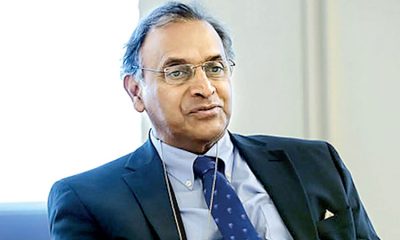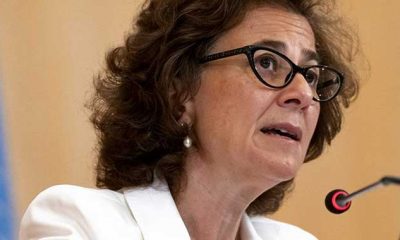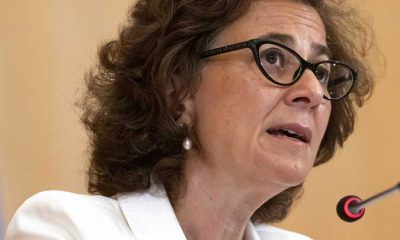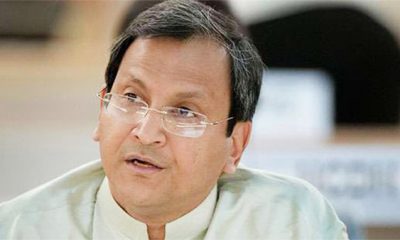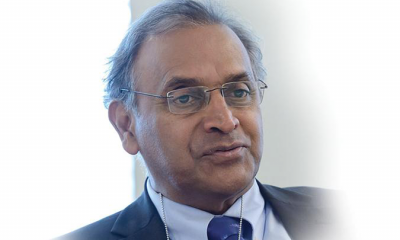Midweek Review
Lanka warned of Extraterritorial jurisdiction
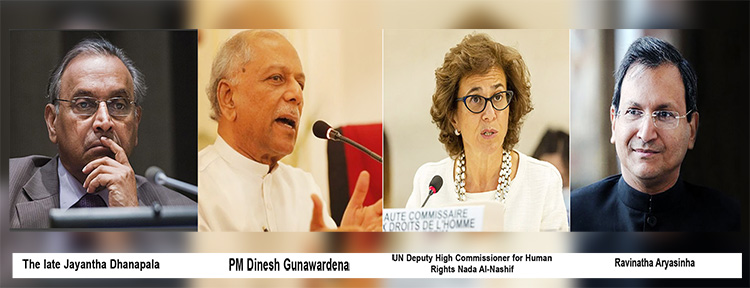
Actually LKI owed public an explanation as to why it never addressed the accountability issue and related matters in spite of it being the toughest foreign affairs challenge faced in post-independence era. There is no harm in addressing a variety of issues of interest but the failure on the part of the LKI to examine this issue by initiating a wider discussion is inexcusable. This criticism also applies to the Kotelawela Defence University (KDU) as it continues to ignore this vital issue.
By Shamindra Ferdinando
Three years after Sri Lanka formally withdrew from an accountability resolution moved against our own country, instigated by the West and the US in particular, the UN body has reiterated that Sri Lanka’s political and military leaderships are under investigation in ‘third states,’ therefore subjected to extraterritorial jurisdiction.
A treacherous Yahapalana government co-sponosred the US-led resolution at the Geneva-based United Nations Human Rights Council.
UNHRC is certainly a club for the rich and powerful, who can kill millions of innocents and render millions more homeless in places like Iraq, Libya, Afghanistan, Syria, etc., by staging turmoil by way of rebellions, regime changes and invasions on false excuses and even commit outright war crimes, but getaway scot-free if you are a member of the self-appointed international community. But a country like little Sri Lanka has no such luck simply because we simply defied the above criminal international community and managed to defeat the world’s most ruthless terrorist organization, despite their underhand nourishment given to it by repeatedly claiming that our security forces were incapable of militarily defeating the LTTE.
UN Deputy High Commissioner for Human Rights Nada Al-Nashif issued the unmistakable warning on 21 June at the 5th session of the HRC. The Jordanian (and her country is a well-known servile follower of the West) dealt with the 2015 US-Sri Lanka joint resolution on reconciliation, accountability and human rights.
Nashif declared that a special team assigned for Sri Lanka that had been established in their Geneva Office to continue to make progress pursuant to resolution 51/1. She stressed: “The team is in the process of providing concrete support to several jurisdictions that have ongoing criminal justice investigations. It is conducting proactive investigative work on key cases and collecting, consolidating and analyzing information and evidence from a variety of UN and other sources, which is preserved in a repository so as to be used for future accountability initiatives. Victims continue to be placed at the heart of this work, including through our active engagement with victim organizations and civil society more broadly.”
Mahajana Eksath Peramuna (MEP) leader Dinesh Gunawardena, who announced Sri Lanka’s withdrawal in March 2020 from the treacherous 2015 accountability resolution, in his capacity as Foreign Minister, is the Prime Minister today. Perhaps Premier Gunawardena should explain the Wickremesinghe-Rajapaksa government’s response to the latest UN declaration.
The then Prime Minister Ranil Wickremesinghe, who gave the go ahead for the signing of the 2015 Geneva resolution, is the President and Commander-in-Chief of the Armed Forces today. President Wickremesinghe, accompanied by First Lady Maithree, was in Europe when Geneva issued the warning. The delegation included National Security Advisor Sagala Ratnayake.
Maithripala Sirisena, under whose watch the co-sponsorship of Geneva resolution took place, is a lawmaker representing the ruling Sri Lanka Podujana Peramuna (SLPP) while war-winning President Mahinda Rajapaksa, too, represents the same party in Parliament. The war-winning Army commander Field Marshal Sarath Fonseka represents the main Opposition Samagi Jana Balawegaya. Unfortunately, none of them at least bothered to exercise their privileges as members of Parliament to counter unsubstantiated allegations.
Obviously with the full blessings of Washington, the Canadian Parliament, in May last year, passed a resolution claiming Tamil genocide in Sri Lanka, unchallenged. A year after the Canadian declaration, retired Rear Admiral Sarath Weerasekera, MP, in his capacity as the Chairman of the Sectoral Oversight Committee on National Security, has suggested that Foreign Minister Ali Sabry, PC, should move a resolution in Parliament to counter the Canadian move. In response to the writer’s query, the Foreign Ministry assured that the suggestion would be dealt with, in consultation with President Wickremesinghe.
In the absence of a cohesive mechanism to counter the Geneva project, the UN has exercised maximum pressure on Sri Lanka. Unfortunately, successive inane governments have simply kicked the can down the road by quite conveniently failing to address war crimes accusations head on by simply exposing to the whole world the double standards of the UN body. By remaining silent those unfairly targeting us have only been given further opportunity to pursue high profile political project meant to introduce a new Constitution at the expense of Sri Lanka’s unitary status.
We as a country should get someone competent to take our case to the world full time, putting aside whatever our political differences.
Except for forthright lawmaker Gevindu Cumatatunga, no one in Parliament has ever declared that the proposed new Constitution should reflect Sri Lanka’s triumph over separatist Tamil terrorism. The leader of civil society organization ‘Yuthukama’ strongly pushed the Gotabaya Rajapaksa’s administration to take the eradication of terrorism into consideration in post-war reconciliation process. Unfortunately, forced by circumstances, and Western intelligence services, and some of their key diplomats working in not so mysterious ways against it, day and night, the erratic GR administration didn’t heed such advice.
The latest Geneva declaration should be examined along with the Canadian declaration of genocide, though for a few days some tended to believe Ottawa was divided over its Sri Lanka stand. But, in response to a specific query as regards the genocide charge, the Canadian High Commission in Colombo reiterated their commitment to 18 May Tamil genocide remembrance day.
Role of LKI
One-time Foreign Secretary Ravinatha Aryasinha, on 19 June, 2023, received appointment as Executive Director, Lakshman Kadirgamar Institute of International Relations and Strategic Studies. The appointment was made by Foreign Minister Ali Sabry in his capacity as Chairman of the Board of Management of the institute. Other members of the board are Suganthie Kadirgamar, widow of the slain much-loved Minister, Rajan Asirwatham, a member of President Chandrika Bandaranaike Kumaratunga’s delegation for talks with the LTTE, Thusantha Wijemanna, one-time legal advisor to External Affairs Ministry, and Malinda Seneviratne, former CEO/Director, Kobbekaduwa Agrarian Research and Training Institute.
Aryasinha retired in September 2021 having last served the country as Sri Lanka’s Ambassador in Washington. Before taking up that appointment in December 2020, Aryasinha served as Foreign Secretary for nearly two years during a turbulent period.
The appointment of Aryasinha took place at a time Geneva has taken an unmistakably dangerous course against us, with Nashif declaring relentless pursuit of Sri Lanka, now at the mercy of Western powers due to an unprecedented financial crisis, leading to IMF loan facility in March this year, entirely on its terms.
It would be pertinent to mention that it was Aryasinha who endorsed the Geneva resolution, in 2015, after some behind-the-scene arm twisting by the then shameless Yahapalana government. In spite of his strong opposition to the resolution, Aryasinha, in his capacity as Sri Lanka’s Permanent Representative in Geneva, had no option but to accept the resolution following instructions issued by the then Foreign Minister, the late Mangala Samaraweera. The then Premier Ranil Wickremesinghe gave the go ahead for the US-led resolution. President Maithripala Sirisena, too, gave his tacit support in terms of the Yahapalana agreement.
Perhaps Aryasinha, now at the LKI’s helm, can pave the way for an in-depth examination of the entire gamut of issues – ranging from UN Secretary General’s Panel of Experts’ investigation into the circumstances Sri Lanka brought the war against the Liberation Tigers of Tamil Eelam (LTTE) to a successful conclusion in May 2009, to the most recent declaration that universal and extraterritorial jurisdiction would be applied against Sri Lanka.
The incumbent government shouldn’t turn a blind eye to the UN backing for investigation and prosecution of the alleged perpetrators and support to the relevant accountability processes in third States, as well, as what it called fair application of targeted sanctions against credibly alleged perpetrators. The reference is very clear. Nada Al-Nashif obviously referred to sanctions imposed by the US and Canada, as well as other countries, including Australia, on the war-winning military. Among those who had been sanctioned were former President Mahinda Rajapaksa, former President Gotabaya Rajapaksa, Field Marshal Sarath Fonseka, Admiral of the Fleet Wasantha Karannagoda, Chief of Defence Staff General Shavendra Silva and Maj. Gen. Chagie Gallage.
In fact, LKI owed the public an explanation as to why it never addressed the accountability issue and related matters in spite of it being the toughest foreign affairs challenge faced in post-independence era. There is no harm in addressing a variety of issues of interest but the failure on the part of the LKI to examine this issue by initiating a wider discussion is inexcusable. This criticism also applies to the Kotelawela Defence University (KDU) as it continues to ignore this vital issue.
Mannar mass graves
Sri Lanka never really exploited the exposure of the blatant UNHRC lie over Mannar mass graves to counter unsubstantiated lies propagated by interested parties. The Western propaganda project regarding Mannar mass graves at one point threatened to overwhelm Sri Lanka but the then Yahapalana government was determined to keep quiet about it.
The Office of UN High Commissioner for Human Rights obviously threw its weight behind those propagating lies. The UN became part of the lie. The Mannar mass graves was accommodated in the annual report of the then UN High Commissioner for Human Rights Michelle Bachelet.
The Commissioner went to the extent of referring to the Mannar mass grave site in her latest annual report (section 23) submitted to the UNHRC. The following is the relevant section: “On May 29, 2018, human skeletal remains were discovered at a construction site in Mannar (Northern Province), Excavations conducted in support of the Office on Missing Persons, revealed a mass grave from which more than 300 skeletons were discovered. It was the second mass grave found in Mannar following the discovery of a site in 2014. Given that other mass graves might be expected to be found in the future, systematic access to grave sites by the Office as an observer is crucial for it to fully discharge its mandate, particularly with regard to the investigation and identification of remains, it is imperative that the proposed reforms on the law relating to inquests, and relevant protocols to operationalize the law be adopted. The capacity of the forensic sector must also be strengthened, including in areas of forensic anthropology, forensic archaeology and genetics, and its coordination with the Office of Missing Persons must be ensured.”
What Bachelet never expected was the US report on Mannar mass graves to go against its strategy. A report by a reputed Miami-based laboratory on the Mannar mass grave samples cleared the Army of the responsibility for extra-judicial killings.
The remains of over 300 men, women and children were found, beginning early 2018, and resulted in high profile accusations of battlefield killings and extra-judicial execution of civilians. Although in terms of the Indo-Lanka Accord that was forced on then President JR Jayewardene by New Delhi, the Indian Army, too, had been deployed there during July 1987 to January 1990, but the know-all UNHRC bluntly pointed the finger at the Sri Lanka Army. During the Indian deployment, the Sri Lankan military was confined to barracks, not only in Mannar, but also the entire northern and eastern administrative districts.
The carbon testing report from the internationally recognized US laboratory concluded that the victims likely died up to 615 years ago — predating even the first European colonization of the country by the Portuguese. That was the end of the sensational Mannar mass grave accusation. But as expected the Tamil National Alliance (TNA) that once served as the LTTE’s representative in Parliament, rejected the US report.
A TNA lawmaker, representing the Vanni region, called for a fresh testing in another lab in some other country. Our Vavuniya correspondent Dinasena Ratugamage quoted Mullaitivu District MP Nirmalanathan Sivamohan as having said:” This is not to say that we do not accept the reports sent by a lab in Florida, US, but given the importance of the Mannar grave site we need to get a second opinion.”
The MP insisted that the lab in Florida had not attempted to identify the victims and further tests were necessary to determine the identity of those in the graves.
A section of the local and foreign media spearheaded a high profile campaign on the basis of Mannar mass graves. Some Colombo-based diplomats, too, supported the project. The then German Ambassador in Colombo, Joern Rohde, visited the site on 27 November, 2018. The German envoy’s visit was followed by a British delegation on 11 December, 2018. The British visit took place close on the heels of the discovery of two pieces of human bones, bound by a cable, on 07 December, 2018. The recovery prompted some ‘experts’, as well as those engaged in excavating the mass grave, to speculate whether some of the people buried there had been tortured before being killed. Interests shown in the Mannar mass grave site by those countries, pushing for full implementation of the Geneva Resolution, unfortunately co-sponsored by the then servile government in Sri Lanka, in October, 2015, strengthened the campaign directed at the Army. A section of the Catholic clergy, too, facilitated the project meant to blame the Army over the Mannar mass grave.
During the propaganda campaign over the Mannar mass graves, the Foreign Ministry and Army Headquarters did absolutely nothing because the then government cooperated fully with the Geneva project. The Yahapalana government response to Mannar was in line with its handling of Lord Naseby’s revelations in October 2017. Even to date, Sri Lanka never made a genuine attempt to use the House of Lords member’s disclosure to our advantage.
On the basis of Foreign and Commonwealth Office (FCO) records obtained with the intervention of the Information Commissioner’s Office, Lord Naseby challenged the very basis of the October 2015 Resolution. Sri Lanka refused to take advantage of the revelation that countered two major allegations (1) killing of 40,000 civilians on the Vanni east front and (2) Sri Lanka political and military leaderships deliberately targeted the civilian community.
The British disclosure coupled with wartime US Defence Advisor Lt. Colonel Lawrence Smith’s declaration in support of Sri Lanka, in June 2011, two years after the conclusion of the war, would help Sri Lanka to build a strong case.
The latest UN warning again highlights Sri Lanka’s pathetic failure to set the record straight. Sri Lanka should place all available information before the international community even if they won’t accept our version.
How govt. ignored JD’s assertion
One of Sri Lanka’s celebrated career diplomats, the late Jayantha Dhanapala, discussed the issue of accountability when he addressed the Lessons Learnt and Reconciliation Commission (LLRC), headed by one-time Attorney General, the late C. R. de Silva, on 25 August, 2010.
Dhanapala, in his submissions, said: “Now I think it is important for us to expand that concept to bring in the culpability of those members of the international community who have subscribed to the situation that has caused injury to the civilians of a nation. I talk about the way in which terrorist groups are given sanctuary; harboured; and supplied with arms and training by some countries with regard to their neighbours or with regard to other countries. We know that in our case this has happened, and I don’t want to name countries, but even countries which have allowed their financial procedures and systems to be abused in such a way that money can flow from their countries in order to buy arms and ammunition that cause deaths, maiming and destruction of property in Sri Lanka are to blame and there is therefore a responsibility to protect our civilians and the civilians of other nations from that kind of behaviour on the part of members of the international community. And I think this is something that will echo within many countries in the Non-Aligned Movement, where Sri Lanka has a much respected position and where I hope we will be able to raise this issue.”
Dhanapala also stressed on the accountability on the part of Western governments, which conveniently turned a blind eye to massive fundraising operations in their countries, in support of the LTTE operations. It is no secret that the LTTE would never have been able to emerge as a conventional fighting force without having the wherewithal abroad, mainly in the Western countries, to procure arms, ammunition and equipment. But, the government never acted on Dhanapala’s advice.
Instead the Mahinda Rajapaksa government squandered over USD 6 mn on a foolish US project in 2014 that didn’t help Sri Lanka at all. That project was meant to thwart the 2015 US resolution in Geneva. The rest is history.
Midweek Review
Batalanda and complexities of paramilitary operations
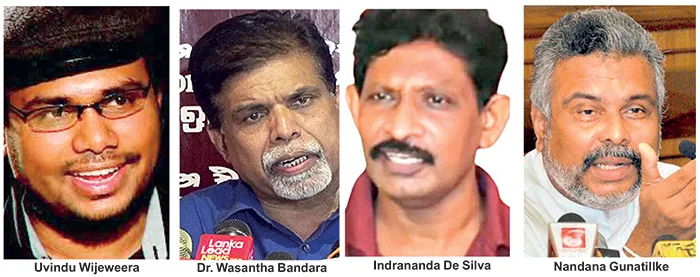
Former President Ranil Wickremesinghe’s recent combative ‘Head-to-Head’ interview with British-American Mehdi Hasan on Al Jazeera has opened a can of worms. As to why Hasan raised the Batalanda Presidential Commission report, during a 49-minute interview conducted at the London’s Conway Hall, with a clearly pro LTTE audience, remains a mystery. This must be yet another notorious way to show how even-handed they are as in the case of its coverage of Russia, China, Palestine or Ukraine for their gullible viewers.
Recorded in February and aired in March 2025, the interview is definitely the most controversial the UNP leader, who is also an Attorney-at-Law, ever faced during his political career; always used to getting kid glove treatment, especially after taking over the party in 1994.
The continuing public discourse on Batalanda should provoke a wider discussion on Sri Lanka’s response to separatist Tamil terrorism, since the cold blooded murder of Jaffna SLFP Mayor Alfred Duriappah, which signalled the beginning of the LTTE terror campaign that ended in May 2009 with the crushing military defeat of the Tigers on the banks of the Nathikadal lagoon, as well as two southern insurgencies in 1971 and 1987-1990.
As Nandana Gunatilleke (one time JVP General Secretary and ex-MP), Dr. Wasantha Bandara (ex-JVPer and close associate of the slain JVP leader Rohana Wijeweera), Indrananda de Silva (ex-JVPer, incumbent Central Committee member of Frontline Socialist Party [FSP] and ex-military photographer) and Uvindu Wijeweera (Rohana Wijeweera’s son and leader of Dewana Parapura) agreed during the recent Hiru ‘Balaya’ discussion, conducted by Madushan de Silva, the Batalanda operation was in line with the overall counter-terrorist/insurgency strategy of the then government.
The issues at hand cannot be discussed at all without taking into consideration the JVP terrorism that, at one-time, almost overwhelmed the UNP’s unbroken rule, since 1977, carried out while openly brushing aside most of the universally accepted genuine parliamentary norms. The country’s second Republican constitution, promulgated by the UNP regime with a 5/6 majority in Parliament, in 1978, had been amended no less than 13 times by the time they were finally ousted in 1995. This was mainly to facilitate their continuous rule. Unfortunately, all stakeholders have sought to take advantage of Batalanda, thereby preventing a proper dialogue. Quite surprisingly, none of the guests, nor the interviewer, bothered, at least, to make a reference to the JVP bid on President J.R. Jayewardene’s life in Parliament on the morning of July 18, 1987. At the time, JVPer Ajith Kumara, working in the House as a minor employee, hurled two hand grenades towards JRJ, with the then Prime Minister Ranasinghe Premadasa seated next to JRJ. While one government MP lost his life, several others suffered injuries, including then National Security Minister Lalith Athulathmudali, whose spleen had to be removed.
At one point, Gunatilleke declared that they assassinated UNP MP for Tangalle Jinadasa Weerasinghe on July 3, 1987, in response to the government killing well over 100 people, in Colombo, protesting against the signing of the Indo-Lanka accord on July 29, 1987. The parliamentarian was killed near the Barawakumbuka-Welangahawela bridge on the Colombo-Rathnapura-Embilipitiya Road. The UNPer was killed on his way home after having declined Premier Premadasa’s offer to make an SLAF chopper available for him to reach home safely.
Against the backdrop of MP Weerasinghe’s assassination and the grenade attack on the UNP parliamentary group that claimed the life of Keethi Abeywickrema (MP for Deniyaya), the government had no option but to respond likewise. The operation, established at the Batalanda Housing scheme of the State Fertiliser Corporation, constituted part of the counter-insurgency strategy pursued by the UNP.
Those who called Batalanda complex Batalanda torture camp/ wadakagaraya conveniently forgot during the second JVP inspired insurgency, the military had to utilize many public buildings, including schools, as makeshift accommodation for troops. Of course the UNP established Batalanda under different circumstances with the then Industries Minister Ranil Wickremesinghe providing political authority. Batalanda had been an exclusive police operation though the Army had access to it whenever a requirement arose.
Those who had been suddenly withdrawn from the Northern and Eastern Provinces, to meet the rapidly evolving security threat in the South, required accommodation. FSP CC member Indrananada de Silva had received unhindered access to Batalanda in his capacity as a military photographer and the rest is history.
As to why Indrananda de Silva switched his allegiance to the FSP should be examined, taking into consideration his previous role as a trusted military photographer, formerly a Lance Corporal of the Military Police. An influential section of the JVP, led by Kumar Gunaratnam, formed the FSP in April 2012 though it didn’t receive the much anticipated public support. Both Indrananda de Silva and Nandana Gunatilleke, who aligned himself with the UNP, found fault with the JVP-led National People’s Power (NPP) over its handling of the Batalanada issue.
Paramilitary operations
Paramilitary operations had been an integral part of the overall counter-insurgency campaign, directed at the JVP responsible for approximately 6,600 killings. Among those death squads were PRRA primarily drawn from the SLMP (Sri Lanka Mahajana Party) and SRRA (the socialist Revolutionary Red Army). PRRA had close links with the Independent Student Union (ISU) whose leader Daya Pathirana was slain by the JVP. The vast majority of people do not remember that Daya Pathirana, who led the ISU during the turbulent 1985-1986 period, was killed mid-Dec. 1989. The second insurgency hadn’t started at that time though the JVP propagated the lie that they took up arms against the UNP government following the signing of the Indo-Lanka peace accord on July 29, 1987.
In addition to PRRA and SRRA, the government made use of paramilitary groups, namely Kalu balallu, Ukkusso, Rajaliyo, Kaha balallu, Kola koti, Rathu Makaru, Mapila, Gonussa, Nee, Keshara Sinhayo, Le-mappillu and Kalu koti.
The UNP also involved some elements of Indian trained Tamil groups (not of the LTTE) in paramilitary operations. Such operations, that had been backed by respective Cabinet Ministers, were supervised by local law enforcement authorities. Paramilitary operations had been in line with psychological warfare that was meant to cause fear among the JVP, as well as the general population. Military operations that had been combined with paramilitary actions received the blessings of the political leadership at the highest level. In the case of Batalanda (1988-1990) President J.R. Jayewardene and Ranasinghe Premadasa knew of its existence.
Even after the eradication of the top JVP leadership, by Nov. 1989, police, military and paramilitary operations continued unabated. Former JVPers appearing on ‘Balaya’ agreed that counter-insurgency operations were actually brought to an end only after D.B. Wijetunga succeeded President Ranasinghe Premadasa after the latter’s assassination on May Day 1993.
After the LTTE resumed war in June 1990, just a couple of months after the withdrawal of the Indian Army (July 1987-March1990), the UNP authorized paramilitary operations in the northern and eastern areas. Members of TELO, PLOTE, EPRLF as well as EPDP were made part of the overall government security strategy. They operated in large groups. Some paramilitary units were deployed in the Jaffna islands as well. And these groups were represented in Parliament. They enjoyed privileged status not only in the northern and eastern regions but Colombo as well. The government allowed them to carry weapons in the city and its suburbs.
These groups operated armed units in Colombo. The writer had the opportunity to visit EPDP and PLOTE safe houses in Colombo and its suburbs soon after they reached an understanding with President Ranasinghe Premadasa. Overnight at the behest of President Premadasa, the Election Department granted these Tamil groups political recognition. In other words, armed groups were made political parties. The Premadasa government accepted their right to carry weapons while being represented in Parliament.
It would be pertinent to mention that thousands of Tamil paramilitary personnel served the government during that period. There had been many confrontations between them and the LTTE over the years and the latter sought to eliminate key paramilitary personnel. Let me remind you of the circumstances, the EPRLF’s number 02 Thambirajah Subathiran alias Robert was sniped to death in June 2003. Robert was engaged in routine morning exercises on the top floor of the two-storeyed EPRLF office, on the hospital road, Jaffna, when an LTTE sniper took him out from the nearby Vembadi Girls’ high school. The operation of the Norway managed Ceasefire Agreement (CFA) made no difference as the LTTE removed Robert who led the party here in the absence of leader Varatharaja Perumal, the first and the only Chief Minister of the North-Eastern Province.
In terms of the CFA that had been signed by Premier Ranil Wickremesinghe and LTTE leader Velupillai Prabhakaran, in Feb. 2002, the government agreed to disarm all paramilitary personnel. Many wouldn’t remember now that during Premadasa’s honeymoon with the LTTE, the Army facilitated the LTTE onslaught on paramilitary groups in selected areas.
Muthaliff’s role
During the ‘Balaya’ discussion, the contentious issue of who shot JVP leader Rohana Wijeweera came up. Nandana Gunatilleke, who contested the 1999 Dec. presidential election. as the JVP candidate, pointing to an article carried in the party organ that dealt with Wijeweera’s assassination said that he wrongly named Gaffoor as one of the persons who shot their leader whereas the actual shooter was Muthaliff. The headline named Thoradeniya and Gaffoor as the perpetrators.
Declaring that he personally wrote that article on the basis of information provided by Indrananda de Silva, Gunatilleke named Asoka Thoradeniya and Tuan Nizam Muthaliff of the Army as the perpetrators of the crime. Thoradeniya served as Sri Lanka’s High Commissioner in the Maldives during the Yahapalana administration, while Muthaliff was killed by the LTTE in Colombo in late May 2005. The shooting took place at Polhengoda junction, Narahenpita. Muthaliff was on his way from Manning town, Narahenpita, to the Kotelawala Defence University.
The programme was told that the JVP had over the years developed close relationship with Thoradeniya while Indrananda de Silva accused Dr. Wasantha Bandara of duplicity regarding Muthaliff. How could you recognize Muthaliff, slain by the LTTE, as a war hero as he was actually one of the persons who shot Rohana Wijeweera, the latter asked.
At the time of his assassination, Muthaliff served as the Commanding Officer, 1 st Regiment Sri Lanka Military Intelligence Corps. The then parliamentarian Wimal Weerawansa was among those who paid last respects to Maj. Muthaliff.
At the time of Rohana Wijeweera’s arrest, Muthaliff served as Lieutenant while Thoradeniya was a Major. Indrananda de Silva strongly stressed that atrocities perpetrated by the police and military in the South or in the northern and eastern regions must be dealt with regardless of whom they were conducting operations against. The former JVPer recalled the Army massacre in the east in retaliation for the landmine blast that claimed the lives of Northern Commander Maj. Gen. Denzil Kobbekaduwa and a group of senior officers, including Brigadier Wijaya Wimalaratne, in early Aug. 1990 in Kayts.
Dr. Wasantha Bandara warned of the Western powers taking advantage of what he called false narrative to push for a Truth and Reconciliation Commission.
It would be pertinent to mention that the LTTE also used the underworld as well as some corrupt Army personnel in planning high profile assassinations. Investigations into the assassination of Muthaliff, as well as Maj. Gen. Parami Kulatunga, killed in a suicide attack at Pannipitiya, in June 2006, revealed the direct involvement of military personnel with the LTTE.
Indrananda de Silva disclosed that soon after Anura Kumara Dissanayake won the presidential election last September, the FSP, in writing, requested the JVP leader to inquire into killings during that period, including that of Rohana Wijeweera. The FSPer alleged that President Dissanayake refrained from even acknowledging their letter. Indrananda de Silva emphasized that Al Jazeera never disclosed anything new as regards Batalanda as he exposed the truth years ago. The former JVPer ridiculed the ruling party tabling the Batalanda Commission report in the wake of Wickremesinghe’s Al Jazeera interview whereas the matter was in the public domain for quite some time.
Indrananda de Silva and Nandana Gunatilleke exchanged words over the latter’s declaration that the JVP, too, was subjected to investigation for violence unleashed during the 1987-1990 period. While the FSPer repeatedly declared that those who carried out directives issued by the party were arrested and in some cases killed, Nandana Gunatilleke took up the position that the party should be held accountable for crimes perpetrated during that period.
The interviewer posed Nandana Gunatilleke the question whether he was betraying his former comrades after joining the UNP. Nandana Gunatilleke shot back that he joined the UNP in 2015 whereas the JVP joined UNP as far back as 2009 to promote retired Army Chef Sarath Fonseka’s presidential ambition even though he wiped out the JVP presence in Trincomalee region during the second insurgency.
JVP’s accountability
Nandana Gunatilleke is adamant that the party should accept responsibility for the killings carried out at that time. The former JVPer declared that Vijaya Kumaratunga (Feb. 16, 1988), first Vice Chancellor of the Colombo University (March 08, 1989) Dr. Stanley Wijesundera, Ven. Kotikawatte Saddhatissa thera (Aug. 03, 1988) and Chairperson of the State Pharmaceutical Corporation Gladys Jayewardene (Sept. 12, 1989) were among those assassinated by the JVP. SPC Chairperson was killed for importing medicine from India, the former Marxist aligned with the UNP said, while actor-turned-politician Kumaratunga’s assassination was attributed to his dealings with President J.R. Jayewardene.
According to Nandana Gunatilleke, except for a few killings such as General Secretaries of the UNP Harsha Abeywickrema (Dec 23, 1987) and Nandalal Fernando (May 20, 1988), the vast majority of others were ordinary people like grama sevakas killed on mere accusation of being informants. The deaths were ordered on the basis of hearsay, Nandana Gunatilleke said, much to the embarrassment of others who represented the interest of the JVP at that time.
One quite extraordinary moment during the ‘Balaya’ programme was when Nandana Gunatilleke revealed their (JVP’s) direct contact with the Indian High Commission at a time the JVP publicly took an extremely anti-Indian stance. In fact, the JVP propagated a strong anti-Indian line during the insurgency. Turning towards Dr. Wasantha Bandara, Gunatilleke disclosed that both of them had been part of the dialogue with the Indian High Commission.
It reminds me of the late Somawansa Amarasinghe’s first public address delivered at a JVP rally in late Nov. 2001 after returning home from 12 years of self-imposed exile. Of the top JVP leadership, Somawansa Amarasinghe, who had been married to a close relative of powerful UNP Minister Sirisena Cooray, was the only one to survive combined police/military/paramilitary operations.
Amarasinghe didn’t mince his words when he declared at a Kalutara rally that his life was saved by Indian Premier V.P. Singh. Soft spoken Amarasinghe profusely thanked India for saving his life. Unfortunately, those who discuss issues at hand conveniently forget crucial information in the public domain. Such lapses can be both deliberate and due to negligence.
By Shamindra Ferdinando
Midweek Review
Independent Monitor
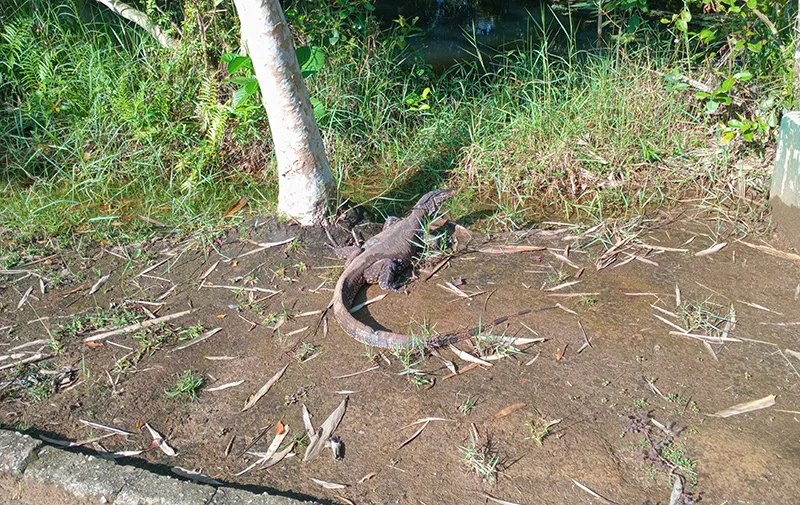
You may think sloth comes very easy,
To your kingly monitor of the shrinking marsh,
As he lies basking smugly in the morn sun,
But he is organized and alert all the while,
As he awaits his prey with patience infinite,
Free of malice, a professional of a kind,
His cumbrous body not slowing his sprite….
But note, he’s no conspirator spitting guile,
And doesn’t turn nasty unless crossed,
Nor by vengeful plans is he constantly dogged,
Unlike those animals of a more rational kind,
Whose ways have left behind a state so sorry.
By Lynn Ockersz
Midweek Review
Rajiva on Batalanda controversy, govt.’s failure in Geneva and other matters

Former President Ranil Wickremesinghe’s recent interview with Mehdi Hasan on Al Jazeera’s ‘Head-to-Head’ series has caused controversy, both in and outside Parliament, over the role played by Wickremesinghe in the counter-insurgency campaign in the late’80s.
The National People’s Power (NPP) seeking to exploit the developing story to its advantage has ended up with egg on its face as the ruling party couldn’t disassociate from the violent past of the JVP. The debate on the damning Presidential Commission report on Batalanda, on April 10, will remind the country of the atrocities perpetrated not only by the UNP, but as well as by the JVP.
The Island sought the views of former outspoken parliamentarian and one-time head of the Government Secretariat for Coordinating the Peace Process (SCOPP) Prof. Rajiva Wijesinha on a range of issues, with the focus on Batalanda and the failure on the part of the war-winning country to counter unsubstantiated war crimes accusations.
Q:
The former President and UNP leader Ranil Wickremesinghe’s interview with Al Jazeera exposed the pathetic failure on the part of Sri Lanka to address war crimes accusations and accountability issues. In the face of aggressive interviewer Mehdi Hasan on ‘Head-to-Head,’ Wickremesinghe struggled pathetically to counter unsubstantiated accusations. Six-time Premier Wickremesinghe who also served as President (July 2022-Sept. 2024) seemed incapable of defending the war-winning armed forces. However, the situation wouldn’t have deteriorated to such an extent if President Mahinda Rajapaksa, who gave resolute political leadership during that war, ensured a proper defence of our armed forces in its aftermath as well-choreographed LTTE supporters were well in place, with Western backing, to distort and tarnish that victory completely. As wartime Secretary General of the Government’s Secretariat for Coordinating the Peace Process (since June 2007 till the successful conclusion of the war) and Secretary to the Ministry of Disaster Management and Human Rights (since Jun 2008) what do you think of Wickremesinghe’s performance?
A:
It made him look very foolish, but this is not surprising since he has no proper answers for most of the questions put to him. Least surprising was his performance with regard to the forces, since for years he was part of the assault forces on the successful Army, and expecting him to defend them is like asking a fox to stand guard on chickens.
Q:
In spite of trying to overwhelm Wickremesinghe before a definitely pro-LTTE audience at London’s Conway Hall, Hasan further exposed the hatchet job he was doing by never referring to the fact that the UNP leader, in his capacity as the Yahapalana Premier, co-sponsored the treacherous Geneva Resolution in Oc., 2015, against one’s own victorious armed forces. Hasan, Wickremesinghe and three panelists, namely Frances Harrison, former BBC-Sri Lanka correspondent, Director of International Truth and Justice Project and author of ‘Still Counting the Dead: Survivors of Sri Lanka’s Hidden War,’ Dr. Madura Rasaratnam, Executive Director of PEARL (People for Equality and Relief in Lanka) and former UK and EU MP and Wickremesinghe’s presidential envoy, Niranjan Joseph de Silva Deva Aditya, never even once referred to India’s accountability during the programme recorded in late February but released in March. As a UPFA MP (2010-2015) in addition to have served as Peace Secretariat Chief and Secretary to the Disaster Management and Human Rights Ministry, could we discuss the issues at hand leaving India out?
A:
I would not call the interview a hatchet job since Hasan was basically concerned about Wickremesinghe’s woeful record with regard to human rights. In raising his despicable conduct under Jayewardene, Hasan clearly saw continuity, and Wickremesinghe laid himself open to this in that he nailed his colours to the Rajapaksa mast in order to become President, thus making it impossible for him to revert to his previous stance. Sadly, given how incompetent both Wickremesinghe and Rajapaksa were about defending the forces, one cannot expect foreigners to distinguish between them.
Q:
You are one of the many UPFA MPs who backed Maithripala Sirisena’s candidature at the 2015 presidential election. The Sirisena-Wickremesinghe duo perpetrated the despicable act of backing the Geneva Resolution against our armed forces and they should be held responsible for that. Having thrown your weight behind the campaign to defeat Mahinda Rajapaksa’s bid to secure a third term, did you feel betrayed by the Geneva Resolution? And if so, what should have the Yahapalana administration done?
A:
By 2014, given the total failure of the Rajapaksas to deal firmly with critiques of our forces, resolutions against us had started and were getting stronger every year. Mahinda Rajapaksa laid us open by sacking Dayan Jayatilleke who had built up a large majority to support our victory against the Tigers, and appointed someone who intrigued with the Americans. He failed to fulfil his commitments with regard to reforms and reconciliation, and allowed for wholesale plundering, so that I have no regrets about working against him at the 2015 election. But I did not expect Wickremesinghe and his cohorts to plunder, too, and ignore the Sirisena manifesto, which is why I parted company with the Yahapalanaya administration, within a couple of months.
I had expected a Sirisena administration to pursue some of the policies associated with the SLFP, but he was a fool and his mentor Chandrika was concerned only with revenge on the Rajapaksas. You cannot talk about betrayal when there was no faith in the first place. But I also blame the Rajapaksas for messing up the August election by attacking Sirisena and driving him further into Ranil’s arms, so that he was a pawn in his hands.
Q:
Have you advised President Mahinda Rajapaksa’s government how to counter unsubstantiated war crimes allegations propagated by various interested parties, particularly the UN, on the basis of the Panel of Experts (PoE) report released in March 2011? Did the government accept your suggestions/recommendations?
A:
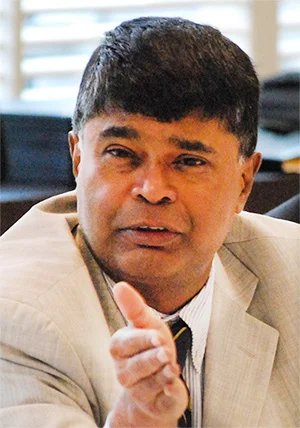
Prof. Rajiva Wijesinha
I kept trying, but Mahinda was not interested at all, and had no idea about how to conduct international relations. Sadly, his Foreign Minister was hanging around behind Namal, and proved incapable of independent thought, in his anxiety to gain further promotion. And given that I was about the only person the international community, that was not prejudiced, took seriously – I refer to the ICRC and the Japanese with whom I continued to work, and, indeed, the Americans, until the Ambassador was bullied by her doctrinaire political affairs officer into active undermining of the Rajapaksas – there was much jealousy, so I was shut out from any influence.
But even the admirable effort, headed by Godfrey Gunatilleke, was not properly used. Mahinda Rajapaksa seemed to me more concerned with providing joy rides for people rather than serious counter measures, and representation in Geneva turned into a joke, with him even undermining Tamara Kunanayagam, who, when he supported her, scored a significant victory against the Americans, in September 2011. The Ambassador, who had been intriguing with her predecessor, then told her they would get us in March, and with a little help from their friends here, they succeeded.
Q:
As the writer pointed out in his comment on Wickremesinghe’s controversial Al Jazeera interview, the former Commander-in-Chief failed to mention critically important matters that could have countered Hasan’ s line of questioning meant to humiliate Sri Lanka?
A:
How could you have expected that, since his primary concern has always been himself, not the country, let alone the armed forces?
Q:
Do you agree that Western powers and an influential section of the international media cannot stomach Sri Lanka’s triumph over separatist Tamil terrorism?
A:
There was opposition to our victory from the start, but this was strengthened by the failure to move on reconciliation, creating the impression that the victory against the Tigers was seen by the government as a victory against Tamils. The failure of the Foreign Ministry to work with journalists was lamentable, and the few exceptions – for instance the admirable Vadivel Krishnamoorthy in Chennai or Sashikala Premawardhane in Canberra – received no support at all from the Ministry establishment.
Q:
A couple of months after the 2019 presidential election, Gotabaya Rajapaksa declared his intention to withdraw from the Geneva process. On behalf of Sri Lanka that announcement was made in Geneva by the then Foreign Minister Dinesh Gunawardena, who became the Premier during Wickremesinghe’s tenure as the President. That declaration was meant to hoodwink the Sinhala community and didn’t alter the Geneva process and even today the project is continuing. As a person who had been closely involved in the overall government response to terrorism and related matters, how do you view the measures taken during Gotabaya Rajapaksa’s short presidency to counter Geneva?
A:
What measures? I am reminded of the idiocy of the responses to the Darusman report by Basil and Gotabaya Rajapaksa, who went on ego trips and produced unreadable volumes trying to get credit for themselves as to issues of little interest to the world. They were planned in response to Darusman, but when I told Gotabaya that his effort was just a narrative of action, he said that responding to Darusman was not his intention. When I said that was necessary, he told me he had asked Chief-of-Staff Roshan Goonetilleke to do that, but Roshan said he had not been asked and had not been given any resources.
My own two short booklets which took the Darusman allegations to pieces were completely ignored by the Foreign Ministry.
Q:
Against the backdrop of the Geneva betrayal in 2015 that involved the late Minister Mangala Samaraweera, how do you view President Wickremesinghe’s response to the Geneva threat?
A: Wickremesinghe did not see Geneva as a threat at all. Who exactly is to blame for the hardening of the resolution, after our Ambassador’s efforts to moderate it, will require a straightforward narrative from the Ambassador, Ravinatha Ariyasinha, who felt badly let down by his superiors. Geneva should not be seen as a threat, since as we have seen follow through is minimal, but we should rather see it as an opportunity to put our own house in order.
Q:
President Anura Kumara Dissanayake recently questioned both the loyalty and professionalism of our armed forces credited with defeating Northern and Southern terrorism. There hadn’t been a previous occasion, a President or a Premier, under any circumstances, questioned the armed forces’ loyalty or professionalism. We cannot also forget the fact that President Dissanayake is the leader of the once proscribed JVP responsible for death and destruction during 1971 and 1987-1990 terror campaigns. Let us know of your opinion on President Dissanayake’s contentious comments on the armed forces?
A: I do not see them as contentious, I think what is seen as generalizations was critiques of elements in the forces. There have been problems, as we saw from the very different approach of Sarath Fonseka and Daya Ratnayake, with regard to civilian casualties, the latter having planned a campaign in the East which led to hardly any civilian deaths. But having monitored every day, while I headed the Peace Secretariat, all allegations, and obtained explanations of what happened from the forces, I could have proved that they were more disciplined than other forces in similar circumstances.
The violence of the JVP and the LTTE and other such groups was met with violence, but the forces observed some rules which I believe the police, much more ruthlessly politicized by Jayewardene, failed to do. The difference in behaviour between the squads led for instance by Gamini Hettiarachchi and Ronnie Goonesinghe makes this clear.
Q:
Mehdi Hasan also strenuously questioned Wickremesinghe on his role in the UNP’s counter-terror campaign during the 1987-1990 period. The British-American journalists of Indian origins attacked Wickremesinghe over the Batalanda Commission report that had dealt with extra-judicial operations carried out by police, acting on the political leadership given by Wickremesinghe. What is your position?
A:
Wickremesinghe’s use of thugs’ right through his political career is well known. I still recall my disappointment, having thought better of him, when a senior member of the UNP, who disapproved thoroughly of what Jayewardene had done to his party, told me that Wickremesinghe was not honest because he used thugs. In ‘My Fair Lady,’ the heroine talks about someone to whom gin was mother’s milk, and for Wickremesinghe violence is mother’s milk, as can be seen by the horrors he associated with.
The latest revelations about Deshabandu Tennakoon, whom he appointed IGP despite his record, makes clear his approval for extra-judicial operations.
Q:
Finally, will you explain how to counter war crimes accusations as well as allegations with regard to the counter-terror campaign in the’80s?
A:
I do not think it is possible to counter allegations about the counter-terror campaign of the eighties, since many of those allegations, starting with the Welikada Prison massacre, which Wickremesinghe’s father admitted to me the government had engendered, are quite accurate. And I should stress that the worst excesses, such as the torture and murder of Wijeyedasa Liyanaarachchi, happened under Jayewardene, since there is a tendency amongst the elite to blame Premadasa. He, to give him his due, was genuine about a ceasefire, which the JVP ignored, foolishly in my view though they may have had doubts about Ranjan Wijeratne’s bona fides.
With regard to war crimes accusations, I have shown how, in my ‘Hard Talk’ interview, which you failed to mention in describing Wickeremesinghe’s failure to respond coherently to Hasan. The speeches Dayan Jayatilleke and I made in Geneva make clear what needed and still needs to be done, but clear sighted arguments based on a moral perspective that is more focused than the meanderings, and the frequent hypocrisy, of critics will not now be easy for the country to furnish.
By Shamindra Ferdinando
-
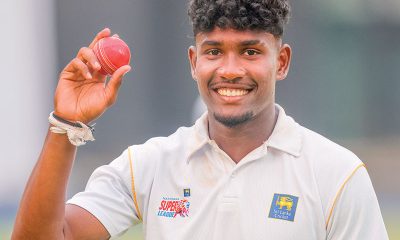
 Sports2 days ago
Sports2 days agoSri Lanka’s eternal search for the elusive all-rounder
-

 Features6 days ago
Features6 days agoCelebrating 25 Years of Excellence: The Silver Jubilee of SLIIT – PART I
-

 Business6 days ago
Business6 days agoCEB calls for proposals to develop two 50MW wind farm facilities in Mullikulam
-
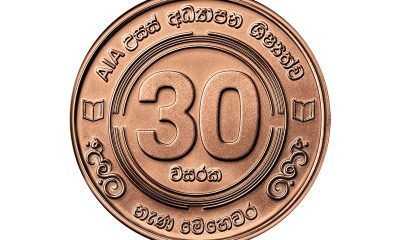
 Business4 days ago
Business4 days agoAIA Higher Education Scholarships Programme celebrating 30-year journey
-
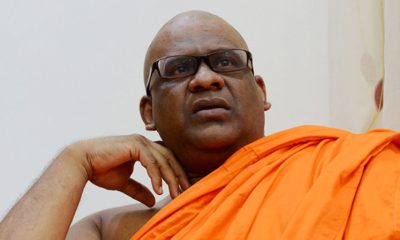
 News3 days ago
News3 days agoGnanasara Thera urged to reveal masterminds behind Easter Sunday terror attacks
-
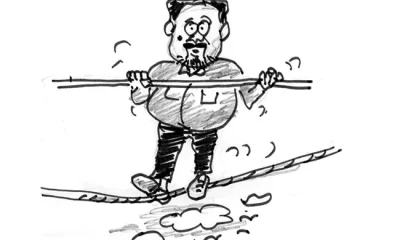
 Features6 days ago
Features6 days agoNotes from AKD’s Textbook
-
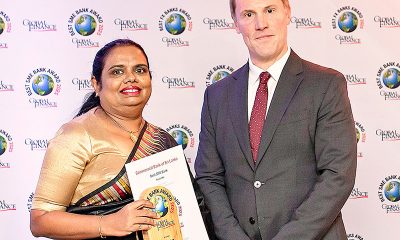
 News2 days ago
News2 days agoComBank crowned Global Finance Best SME Bank in Sri Lanka for 3rd successive year
-
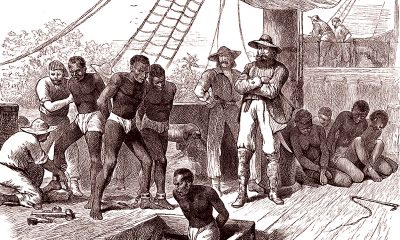
 Features2 days ago
Features2 days agoSanctions by The Unpunished


